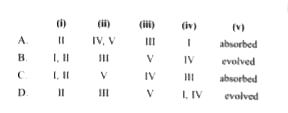Fill in the blanks with appropriate words. Benzene has a planar structure. All carbon atoms in benzene are (I)____ hybridised. The ring structure of benzene was proposed by (II)________. It shows (III)_______substitution reactions. It reacts with (IV)_________in presence of aluminium chloride to form acetophenone.
I−sp2,II-Kekule, III-electrolphilic, IV-acetyl chloride
I−sp, II-Dewar, III-Nucleophilic, IV-chloroethane
I−sp2, II-Ladenberg, III-electrophilic, IV-chloroethane
I−sp2, II-Baeyer, III-nucleophilic, IV-methyl bromide
The correct Answer is:A
Topper's Solved these Questions
- HYDROCARBONS BOOK - NCERT FINGERTIPSCHAPTER - HYDROCARBONS EXERCISE - Higher Order Thinking Skills
2 Videos
- HYDROCARBONS BOOK - NCERT FINGERTIPSCHAPTER - HYDROCARBONS EXERCISE - Higher Order Thinkin Skills
5 Videos
- HYDROCARBONS BOOK - NCERT FINGERTIPSCHAPTER - HYDROCARBONS EXERCISE - Alkynes
17 Videos
- EQUILIBRIUM BOOK - NCERT FINGERTIPSCHAPTER - EQUILIBRIUM EXERCISE - Assertion And Reason
15 Videos
- HYDROGEN BOOK - NCERT FINGERTIPSCHAPTER - HYDROGEN EXERCISE - Assertion And Reason
15 Videos
Similar Questions
Write balanced equation using structural formula wherever relevant and name the products in the reactions taking place when benzene is treated with methyl chloride in the presence of anhydrous aluminium chloride.
View SolutionA few reactions are listed below:
I. Hydrogen + Oxygen → Water II. Calcium oxide + Carbon dioxide → Calcium carbonate III. Silver nitrate + Copper → Copper nitrate + Silver IV. Sodium hydroxide + Hydrochloric acid → Sodium chloride + Water V. Sodium nitrate → Sodium nitrite + Oxygen
Now, read the given passage and fill in the blanks by selecting an appropriate option. Reaction(s) ___(i) is/are combination reaction(s), reaction(s) ____(ii) is/are single displacement reaction(s), while reaction____(iii) is a decomposition reaction. Reaction(s)____ (iv) is/are neutralisation reaction(s) and heat energy is ____(v) in this/these reaction(s).

View Solution
Knowledge Check
Arrange in order of decreasing trend towards SE (Substitution electrophilic) reactions: (I) Chlorobenzene (II) Benzene (III) Anilinium chloride (IV) Toluene
AII gt I gt III gt IVBIII gt I gt II gt IVCIV gt II gt I gt IIIDI gt II gt III gt IVArrange in order of decreasing trend towards electrophilic substitution reactions: Chlorobenzene (I) , benzene(II), toluene(III), anilinium chloride (IV)
AIII>II>I>IVBIV>I>II>IIICII>I>IV>IIIDI>II>IV>IIIConsider the following compounds
(i) Chloroethane (ii) Benzene (iii) 1,3-butadiene (iv) 1,3,5-hexatriene
All the carbon atoms are sp2 hybridized inA(i),(iii),(iv),onlyB(i),(ii), onlyC(ii),(iii),(iv),onlyD(iii),(iv),only
Write the reactions showing the presence of following in the open structure of glucose :
(i) A carbonyl group (ii) Straight chain with six carbon atoms
View SolutionFill in the blanks with the correct words from the brackets:
Alkenes are the (i) __________ analogous /homologous) series of (ii) ___________(saturated / unsaturated) hydrocarbons. They differ from alkanes due to the presence of (iii) ______ (double/single) bonds. Alkenes mainly undergo (iv) __________ (addition / substitution) reactions.
View SolutionWhich of the following reaction is /are correct regarding the preparation of ketone?
I treatement of acyl chlorides with dialkyl cadmium prepared by the reaction of cadmium chloride with grignard reagent gives ketone.
II when benzene or substituted benzene is treated with acid chloride in the presence of anhydrous aluminium chloride it gives the corresponding ketone this reaction is known as friedel craft acylation reaction.
III Treating a nitrile with grignard reagent followed by hydrolysis yields a ketone
select the correct option
View SolutionWhich of the following statement is correct regarding structure of benzene?
I.All the six carbons in benzene are sp2 hybridised
II.sp2 hybridised orbital of carbon combines with another sp2hybridised orbital of carbon to give C-C sigma bonds.
III.C-H sigma bond is obtained by lateral overlapping of sp2hybridised orbital of C and 1s orbital of H atom.
Choose the correct statement
View Solutionn−Propyl benzene can be obtained in quantitative yield by following method :
(i) By treating benzene with n− propyl chloride in presence of AlCl3
(ii) By treating excess of benzene with n−propyl chloride in presence of AlCl3
(iii) By treating benzene with allyl chloride in presence of AlCl3 followed by reduction
(iv) By treating benzene with propionyl chloride in the presence of AlCl3 followed by Clemmensen reduction
View Solution
